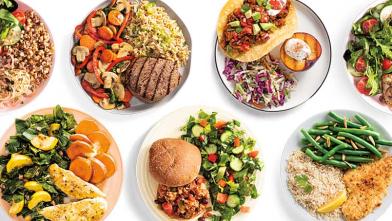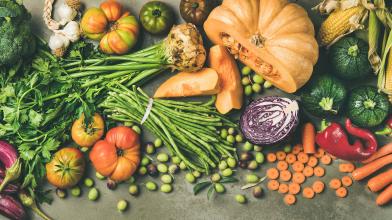The American Diabetes Association’s (ADA’s) Nutrition and Wellness team includes registered dietitian nutritionists who curate and create tools and resources that translate the science of the ADA’s Standards of Care in Diabetes and the Nutrition Consensus into accessible education to help improve individual and community health.
ADA’s Food & Nutrition Philosophy
At the ADA we believe that informed food choices are essential to preventing and living well with diabetes.
Food choices should be personalized, accessible, shaped through the lens of culture and community, and guided by national standards and recommendations for health and wellness.
There are several keys to healthy eating. Because every person’s health journey is unique, it’s important to provide support for a wide range of experiences and skills. For specific individual recommendations, we encourage you to check in with your own health care team.
Some Keys for Healthy Eating:
- Personalized: The food we eat should be accessible, offer balance to our schedules and cooking skills, reinforce our culture, and use our resources to the best of our abilities.
- Quality: Every opportunity to eat is an opportunity that can support your overall health. We encourage people to lean into current science-based recommendations and include foods that are less processed, more plant-based, and offer more “nutrient bang for your buck.” A great tool to help get you started is the Diabetes Plate.
- Intentional: While a single meal or snack is unlikely to wreck your health goals, a good plan is to focus on the big picture and overall pattern of choices. Be mindful and present. If you want to have a treat, think about ways to adapt other parts of the meal or pattern for the day. Planning your meal selections, monitoring your blood glucose (blood sugar), and making sure you have healthy food options with you are all helpful ways to manage diabetes. Striving for progress and not perfection helps support a mindful approach.
- Community: Food is a shared experience and finding ways to be with others during the cooking and eating experience helps us savor our connections as well as our foods. It is also important to encourage one another on our journeys and not shame or blame people for their choices.
- Progress: The skills we have when we are first starting our diabetes journey are likely different after we become more “seasoned.” Your diabetes management strategies may change over time too. Find what best fits your current stage and move on from there. If your current pattern is lacking nutrition, work with your health care team to find manageable and maintainable steps to work toward your health goals. As you make changes and gain success, add new skills to move to the next level.
Our Recipes
Our recipes strive to provide better-for-you options for people with prediabetes or diabetes. This includes a variety of ingredients and nutrition as we take an entire day’s meals into consideration. We create flexible options to help support people’s personal preferences when we can. For example, there are some people who do not want to use sugar-free or low-calorie sweeteners, so we include some recipes that offer other sugar-related ingredients. The bottom line is being mindful of the total grams of carbohydrate when managing diabetes.
We always provide the nutrition facts so each person has the nutrition information for the recipe to help them choose the ones that best fit their health goals and their specific eating pattern. Our focus is on increasing positive nutrients (fiber and protein) and being mindful of nutrients of concern for certain health conditions (total calories, carbohydrates, added sugar, sodium, and saturated fat). We also encourage creativity in the kitchen. If you want to leave out or swap an ingredient, give it go!
Our recipe analysis uses the Nutrition Facts label which is based on 2,000 calories per day. If your eating pattern is a different calorie level, you will need to adjust the percent Daily Value calculations. Total calories and grams of nutrients, like carbohydrates, will still be key reference measures, especially for those who are using these numbers to calculate their medication dosages.
One Last Thought
Recipes provided by the ADA are designed to help people with prediabetes or diabetes make informed choices for their own meal planning and preparation. It is important to always practice routine blood glucose monitoring when adding new foods and recipes to your eating plan to account for individual response or variations in ingredients. People with additional medical conditions or dietary restrictions should follow the recommendation of their health care professionals when making choices about foods that fit into their specific eating pattern.








